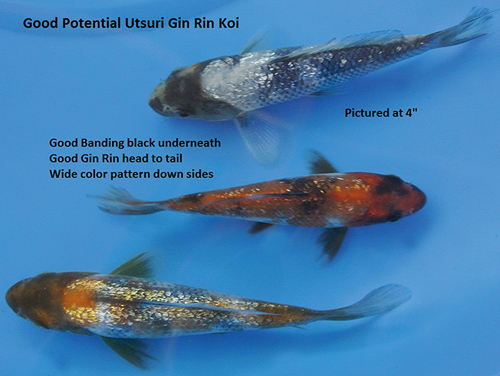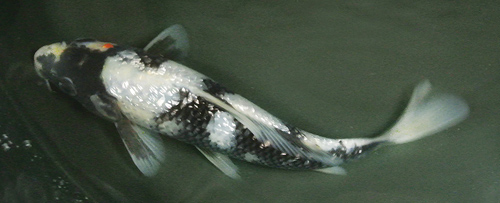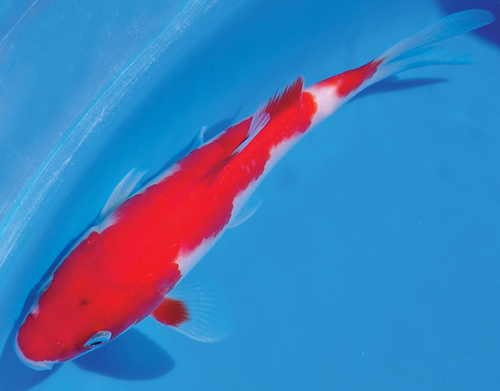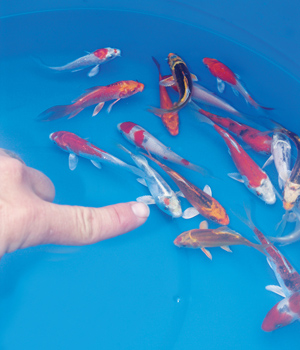
One of the most enjoyable aspects of owning a koi pond is picking out your new pond family members. A trip to your local koi dealer is exciting, and you generally have a plan in mind before you walk through the gates. For instance, how many koi do you need? What size? Which colors or classifications are you hoping to find, and how much are you willing to spend? Whether you are shopping to add beauty to your pond or shopping for a future show koi, the reality soon takes hold when you look into the tanks and cannot decide. Are you making the right decision?!
“What will this koi look like in a few years? Should I buy large or small? Who can help me?”
Gambling with Tosai
When we look at koi, we have to understand that what we see when we are buying Tosai (one-year-old koi) is not what we may see in the future. This is especially true when we are buying baby koi in the typical 3-to-5-inch and 6-to-8-inch ranges. That perfect Sanke at 6 to 8 inches today may be a show-winner in three years. Or, it could be bleached out or blackened and lose all color and value. Will the colors run or splotch? Will the pattern improve with the growth of the koi? Will the black take over? Will the red disappear? These are questions that we all ask, novice and professional, because it is not a perfect science. And that is what makes “growing out” koi exciting. It is a fun and dynamic hobby.
No matter how experienced, you have no guarantees in choosing baby koi. This fact is at the heart of the reality that most koi show winners are purchased as larger fish already. With grown koi, you can see what you are getting. But breeders and many hobbyists alike enjoy the challenge and the game of raising the koi from babies and gambling with a little luck.Picking the Greats
So how do you pick future greats when they are merely 4 to 6 inches now? How do you guess what the fish will look like in three years? Although it is not a science, there are definite traits we look for in baby koi that increase the likelihood that our new little addition will add great beauty to our pond for years to come.
We are going to discuss three of those traits: Body and Quality; the Red and the Black; and finally, Pattern.
Body and Quality
 First and foremost, we have to buy the healthiest fish, as this is key in growth potential. Make sure the fish is swimming normally, socializing with the other koi in the tank, has no apparent fin or body flaws and has head and tail potential. When we look at the head, we are looking for a broad head and good separation between the eyes, signifying the likelihood that the fish will grow larger. At the tail, we are looking for a wider tail joint so that when the koi is larger, the thickness will “show” more powerful conformation.
First and foremost, we have to buy the healthiest fish, as this is key in growth potential. Make sure the fish is swimming normally, socializing with the other koi in the tank, has no apparent fin or body flaws and has head and tail potential. When we look at the head, we are looking for a broad head and good separation between the eyes, signifying the likelihood that the fish will grow larger. At the tail, we are looking for a wider tail joint so that when the koi is larger, the thickness will “show” more powerful conformation.
“Skin quality” means high gloss and shine as well as purity of color. Ultimately, how detailed the breeders are in their culling and their use of trusted bloodlines really makes a difference. This is why you should buy from sources that have a tradition for great koi. Certain farms are known for high gloss, pure whites, deep reds, Ginrin or reticulation patterns from head to tail, et cetera.
The Black and the Red
Inspect the black, buy the red. When choosing reds (Hi) and blacks (Sumi), seeing the fish in the future is critical to your selection. Red is the baseline “must-have” to consider the koi. However, red is delicate in small koi, so you want to look for deep, consistent red from the front to the back of the koi and in large patterns rather than splotches. Consistency from head to tail and side to side is what we want our Hi (red) to become. Of course, we need to see the potential future two-step/three-step/four-step pattern down the dorsal, but it is more than pattern. The red has to stay there, and that is why we are looking at the details of the coloring beyond the pattern.
To best guess where we will keep the red, we look at the edges of coloring. We want the head side of the red patterns to be a little blurred, because we are looking at those red scales under the white scales in front of them. This gets cleaned up when the koi grows. If we do not see this, then the red is likely shallow and the front line of red will change. In the sides and tail end of the color patches, we want to see defined separation between the red and the white rather than a messy mixture. Bold red is the ultimate goal.
Where the Hi is your baseline on the white painter’s canvas, your Sumi (black) is the icing on the cake. Sumi can be equally hard to predict and even more frustrating than red because often times underlying Sumi never develops. So you choose a Showa with great Hi and a potential Sumi pattern that would be “show-worthy,” and then half of the Sumi does not develop and you are left with a poor-quality koi with black only at the tail, or scattered. Or, when the black does rise, it is flat rather than high-quality gloss.


[box]This baby Shiro Utsuri Ginrin and Tosai Inazuma Kohaku have great potential. Both display great body shape; their color is deep, broad, and defined; and their patterns have winning potential.[/box]
When we look at the black, we want to see two things. First, we want at least one scale of good Sumi present in the young koi we can judge well (most Sumi is under the top layers of scales in baby koi, so you are looking through red or white scales and unable to determine quality of black).
Second, we want the black to be darker in the center of the scale than on the edge. You can check the center of the scale by carefully bending the fish to spread the scales apart and looking between them to see the color going through to the body of the fish, although this is not very commonly allowed by retailers in order to maintain the safety of the fish. If the outside edge of the scale is darker, be it Sumi or Hi, this is not a stable color and will likely go away. We want to see color that is darkest deep into the scale. This is the color that will develop well. Also, for a truer mark, pay more attention to how good the black on white is and less attention to the black on red.
Pattern
Pattern is what most buyers see, and it overwhelms the above qualities that are more important. In saying that, though, pattern is ultimately what sets apart the good from the great. One of the critical elements to look for in pattern is how far down the side of the baby koi the pattern falls. As the koi matures, it broadens its body shape, so a baby koi with far-reaching pattern down the sides, below the lateral line, will hold more color pattern as it grows and the pattern “spreads” across the wider body. It is critical that pattern exist from head to tail, but when selecting baby koi you have to know that generally speaking, red is stronger near the head and weaker toward the tail. Also, black starts heavier at the tail and often works its way up the fish with age (in Sanke and Showa primarily).
 Remember, you are buying koi that have not “filled out” yet. The most common mistake in buying baby koi is buying what you see and not what you don’t see. You need to know what color patterns do with maturity and predict where colors will change. For example, it’s very likely that a great three-step adult Kohaku was the baby Kohaku that had solid red head to tail that looked too plain. But an educated and experienced eye might have seen “stepping” potential in the red that would occur as the fish broadens and the red stretches, allowing white to show through.
Remember, you are buying koi that have not “filled out” yet. The most common mistake in buying baby koi is buying what you see and not what you don’t see. You need to know what color patterns do with maturity and predict where colors will change. For example, it’s very likely that a great three-step adult Kohaku was the baby Kohaku that had solid red head to tail that looked too plain. But an educated and experienced eye might have seen “stepping” potential in the red that would occur as the fish broadens and the red stretches, allowing white to show through.
It is a gamble buying baby koi, but it can be the most enjoyable and rewarding part of the hobby. Shop reputable suppliers, listen to trusted experts, have them “bowl” several fish for you to compare side by side, and you may raise a Show Champion one day by shopping out of the 5-to-7-inch tank. And that would be an achievement any hobbyist would be proud of!



Excellent article, well explained for any layperson to get started on a koi search adventure.